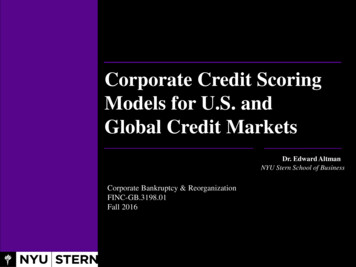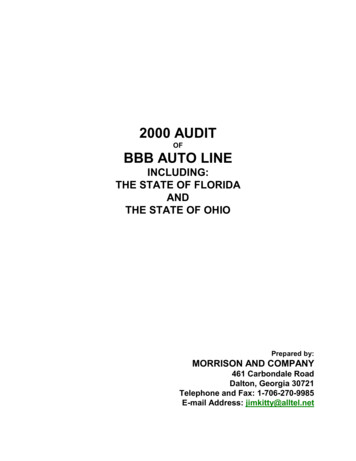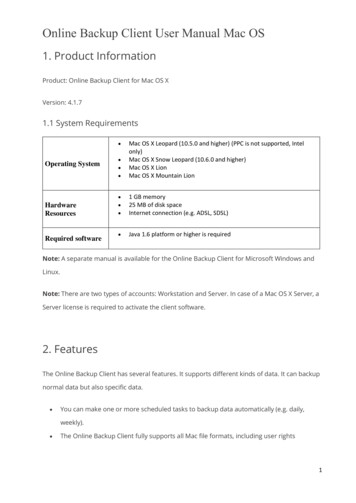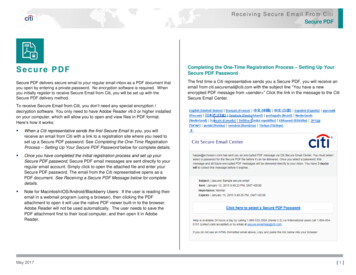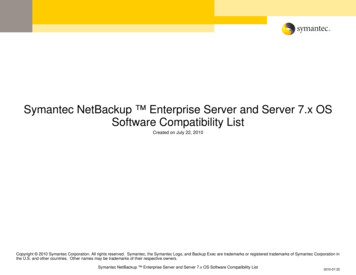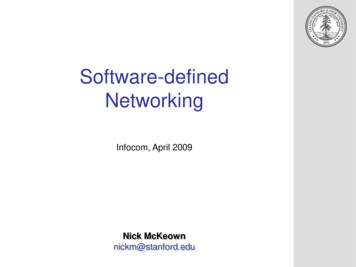
Transcription
BBB Secure Nonce Based MAC Using PublicPermutationsAvijit Dutta and Mridul NandiIndian Statistical Institute, Kolkata.avirocks.dutta13@gmail.com, mridul.nandi@gmail.comAbstract. In the recent trend of CAESAR competition and NIST lightweight competition, cryptographic community have witnessed the submissions of several cryptographic schemes that are build on public random permutations. Recently, in CRYPTO 2019, Chen et al. have initiated an interesting research direction in designing beyond birthdaybound PRFs from public random permutations and they proposed twoinstances of such PRFs. In this work, we extend this research directionby proposing a nonce-based MAC build from public random permutations. We show that our proposed MAC achieves 2n/3 bit security (withrespect to the state size of the permutation) and the bound is essentiallytight. Moreover, the security of the MAC degrades gracefully with therepetition of the nonce.Keywords: Faulty Nonce, Mirror Theory, Public Permutation, ExpectationMethod.1IntroductionNonce-Based MAC. Message Authentication Code (or in short MAC) is animportant cryptogaphic primitive to authenticate any digital message or packettransmitted over an insecure communication channel. When a sender wants tosend a message m, she computes a MAC function with input m, the shared secretkey k, and possibly an auxiliary input variable ν (called nonce), and obtains atag t. Then she sends (ν, m, t) to the receiver. Upon receiving, receiver verifiesthe authenticity of (ν, m, t) by computing the MAC using (ν, m, k) and checkswhether the computed tag t0 matches with t.Wegman-Carter (WC) MAC [25] is the first example of a nonce-based MACwhich masks the hash value of the message with an encrypted nonce to generate the tag. WC MAC gives optimal security when the nonce is unique forevery authenticated messages. However, its security is compromised if the noncerepeats even once. Wegman-Cater MAC, when instantiated with a polynomialhash, then the repetition of the nonce reveals the hash key of the polynomialhash. However, maintaining the uniqueness of the nonce for every authenticatedmessages is a challenging task in practical contexts. For example, it is difficultto maintain the uniqueness of the nonce while implementing the cipher in a
2Avijit Dutta and Mridul Nandistateless device or in cases where the nonce is chosen randomly from a small set.The nonce may also accidentlly repeats due to a faulty implementation of thecipher or due to the fault occured by resetting of the nonce itself [4]. Therefore,the guard from the nonce repetition attack is much desired from a nonce-basedMAC.As a remedy of this, Encrypted Wegman-Carter-Shoup (EWCS) [11] MAC wasproposed that guarantees the security even when the nonce repeats. But itssecurity is limited only up to the birthday bound even when nonce is unique.To this end, Encrypted Wegman-Carter with Davies-Meyer [11] (or EWCDM)and Decrypted Wegman-Carter with Davies-Meyer [13] (or DWCDM) have beenproposed that gives beyond the birthday bound security when nonce is unique 1and birthday bound security when nonce repeats 2 . However, the security ofboth these constructions fall to the birthday bound with a single repetitionof the nonce, i.e., if the nonce ever repeats accidentally, security of both theconstructions immediately drops to the birthday bound.Nonce Based Enhanced Hash-then-Mask. In FSE 2010 [21], Minematsuproposed EHtM, a beyond birthday bound secure probabilisitic MAC. It is buildupon two independent n-bit keyed functions Fk1 and Fk2 and an n-bit axu hashfunction Hkh , defined as follows: EHtM(m) (r {0, 1}n , Fk1 (r) Fk2 (r Hkh (m))).This construction has been further analyzed in [15] for improving its securitybound. In Eurocrypt 2019, Dutta et al. [16] proposed a nonce-based variant ofEHtM, called nEHtM MAC, where the random salt r is replaced by an n 1bit nonce value ν and an n-bit block cipher Ek is used as an internal primitiveinstead of two independent n-bit keyed functions. Schematic diagram of nEHtMis shown in Fig. 1.1. Similar to EWCDM and DWCDM, nEHtM gives beyond the(birthday bound) security in nonce-respecting (resp. nonce misuse) setting. But,unlike these two constructions, security of nEHtM MAC degrades gracefully withthe repetition of the nonce. In other words, security of nEHtM remains beyondthe birthday bound with a single repetition of the nonce (which is not true forEWCDM and DWCDM). That is, one can get adequate security from nEHtM if therepetition of the nonce occurs in a controlled way, a feature which is not presentin EWCDM or DWCDM. This phenomena is formally captured by a notion, calledfaulty nonce model [16]. Informally, it says that a nonce is faulty if it appearsin a previous signing query. It has been stated in [16] that faulty nonce model isa weaker notion than multicollision of nonces – a natural and a popular metricto measure the misuses of nonce. Under the notion of faulty nonce model, Duttaet al. have shown that nEHtM is secured roughly upto 22n/3 queries.We would like to mention here that this construction was also analyzed by Mochand List [22] in parallel to [16] in the name of HPxNP, where two independentn-bit block ciphers have been used (as they did not use the domain separation12We call this notion nonce-respecting settingWe call this notion nonce-misuse setting
BBB Secure Nonce Based MAC Using Public Permutations3technique). However, Moch and List analyzed its security under the condition ofthe uniqueness of the nonce, whereas Dutta et al. [16] proved its graceful securitywith respect to the repetition of the nonce.1.1Permutation Based CryptographyAll the above discussed nonce-based MACs are build on block ciphers as theirunderlying primitives and even stronger, these primitives are evaluated only inthe forward direction. As most of the block ciphers are designed to be efficient inboth the forward and the inverse direction, block ciphers are over-hyped primitives for such purpose [10]. On the other extreme, cryptographic permutationsare particularly designed with the motive to be fast in the forward direction, butnot neccessarily in the inverse direction. Examples of such permutation includesKeccak [2], Gimli [1], SPONGENT [5]. Moreover, in most of the cases evaluatingan unkeyed public permutation is faster than evaluating a keyed block cipher,as the latter involves in evaluating the underlying key scheduling algorithm eachtime the block cipher is invoked in the design. With the advancement of publicpermutation-based designs and the efficiencies of evaluating it in the forward direction, numerous public permutation-based inverse-free hash and authenticatedencryption designs have been proposed. The use of cryptographic permutationgained the momentum during SHA-3 competition [24]. Furthermore, the selection of the permutation-based Keccak sponge function as the SHA-3 standardhas given a high level of confidence on using this primitive in the community.Today, permutation-based sponge construction has become a successful and afull-fledged alternative to the block cipher-based modes. In fact, in the firstround of the ongoing NIST light-weight competition [23], 24 out of 57 submissions are based on cryptographic permutations, and out of 24, 16 permutationbased proposals have been qualified for the second round. This statistics, beyondany doubt, clearly depicts the wide adoption of permutation based designs [7, 1,3, 8, 12, 14] in the community. In another direction, a long line of research workhas been carried out in the study of designing block ciphers and tweakable blockciphers out of public random permutations. Even Mansour (EM) [17] and Iterated Even Mansour (IEM) cipher [6] are the notable approaches in this direction.Nonce-based MAC build from Public Permutations. Nonce-based MACsusing public permutations are mostly designed with sponge type of constructions. But the drawback of such designs are: (i) they do not use the full size ofthe permutation for guarranting security and (ii) they attain only the birthdaybound security in the size of its capacity c, i.e., c/2 bit security (except Bettle [7], whose security bound is roughly the size of its capacity). Now, it is anadmissible fact that the sponge type designs, which offer c/2-bit security, aregood in practice when they are instantiated with large size permutations suchas Keccak [2], whose state size is 1600 bits. But such large size permutationsare not suitable for use in resource constrained environment. In such scneario,instead of using such large size permutations, one aims to use light-weight permutations such as SPONGENT [5] and PHOTON [18], whose state size go as
4Avijit Dutta and Mridul Nandilow as 88 and 100 bits respectively. If we use these light-weight permutationsas underlying primitives in birthday bound secure sponge type constructions,then it practically offers inadequate security. As a result, sponge type constructions instantiated with light-weight permutations are not suitable for deployingin resource constrained environment. Thus, it is natural to askCan we design a public permutation-based nonce-based MAC that gives anadequate security when instantiated with light-weight permutation ?This question hinted us to think of designing a MAC whose security depends onthe entire size of the underlying permutation (unlike sponge type constructionswhose security depends on only a part of the entire size of the underlying permutation) and the security must cross the birthday barrier. Coming up with sucha design is the goal of this paper. In this direction, Chen et al. [10] have showntwo instances of public permutation-based pseudo random functions that givebeyond the birthday bound security with respect to the size of the permutation.We extend this line of research work by designing a public permutation-basednonce-based MAC that gives beyond the birthday bound security with respectto the size of the permutation.Our Contribution. The sole contribution of this paper is to design a beyondbirthday bound secure nonce-based MAC using public random permutations.To this end we propose nEHtMp , a nonce based MAC desiged using public permutations. As depicted in Fig. 1.1, our construction structurally resembles tothe nEHtM MAC [16] where we replace its block cipher with a public randompermutation and an appropriate masking of the key.mνHk 0n 10 1Ekνn 1 kmEkHk 0n 10 n 1x k1π1 1kπ k2ππ2 tt k3yFig. 1.1. (Left): nEHtM MAC based on block cipher Ek ; (Middle): nEHtMp MAC basedon single public random permutation π; (Right): 2-round iterated even mansour cipher.Note that, by instantiating the underlying block cipher of nEHtM MAC with 2round iterated Even-Mansour cipher (as shown in Fig 1.1), one can easily make
BBB Secure Nonce Based MAC Using Public Permutations5the public permutation variant of nEHtM MAC, which becomes secure beyondthe birthday bound (in faulty nonce model). However such transformation requires 4 permutation calls, 7 xor operations and one hash evaluation. Comparedto this, nEHtMp requires only 2 permutation calls, 3 xor operations and onehash evaluation. We have shown that nEHtMp is secured roughly up to 22n/3queries in the nonce-respecting setting. Moreover, this security bound degradesin a graceful manner under the faulty nonce model [16]. We show the unforgeability of this construction through an extended distinguishing game and applythe expectation method to bound its distinguishing advantage. We also showthat our proven security bound is tight by giving a matching attack on it withroughly 22n/3 query complexity and 22n 4 time complexity 3 .2PreliminariesGeneral Notations: For n N, we denote the set of all binary strings oflength n and the set of all binary strings of finite arbitrary length by {0, 1}nand {0, 1} respectively. We often refer the elements of {0, 1}n as block. For ann-bit binary string x (xn 1 . . . x0 ), msb(x) denotes the first bit of x in left to right ordering, i.e. msb(x) xn 1 . Moreover, chopmsb (x) (xn 2 . . . , x0 ),i.e., chopmsb (x) returns the string x by dropping just its msb. For any elementx {0, 1} , x denotes the number of bits in x and for x, y {0, 1} , xky denotesthe concatenation of x followed by y. We denote the bitwise xor operation ofx, y {0, 1}n by x y. We parse x {0, 1} as x x1 kx2 k . . . kxl wherefor each i 1, . . . , l 1, xi is a block and 1 xl n. For a sequence ofelements (x1 , x2 , . . . , xs ) {0, 1} , xia denotes the a-th block of i-th element xi .For a value s, we denote by t s the assignment of s to variable t. For anynatural number j N, hjis denotes the s bit binary representation of integerj. For i {0, 1}n , leftk (i) represents the leftmost k bits of i. Similarly, rightk (i)represents the rightmost k bits of i. For any finite set X , X X denotes thatX is sampled uniformly at random from X and X1 , . . . , Xs X denotes thatXi ’s are sampled uniformly and independently from X . FX (n) denotes the setof all functions from X to {0, 1}n . We often write F(n) when the domain is clearfrom the context. We denote the set of all permutations over {0, 1}n by P(n).For integers 1 b a, (a)b denotes the product a(a 1) . . . (a b 1), where(a)0 1 by convention and for q N, [q] refers to the set {1, . . . , q}.2.1Public Permutation Based Nonce Based MACLet F : K N M T be a keyed function where K, N , M and T are the keyspace, nonce space, message space and the tag space respectively. We assume thatF makes internal calls to the public random permutations π (π1 , . . . , πd ) ford 1, where all of the d permutations are independent and uniformly sampled3time complexity does not refer to the evaluation of permutations, but only refers tothe time required to find a suitable matching pair
6Avijit Dutta and Mridul Nandifrom P(n) for some n N. For simplicity, we write Fπk to denote F with uniform kand uniform π. Based on Fπ,wedefinethenonce-basedmessage authenticationkcode I (I.KGen, I.Sign, I.Ver) build from public permutations as follows: Fork K, the signing algorithm I.Signk , takes as input (ν, m) N M andoutputs t Fπk (ν, m) and the verification algorithm I.Verk , takes as input(ν, m, t) N M T and outputs 1 if Fπk (ν, m) t; otherwise it outputs 0.A signing query (ν, m) by an adversary A is called a faulty query if A hasalready queried to the signing algorithm with the same nonce but with a differentmessage. Let A be a (η, qm , qv , p, t)-adversary against the unforgeability of I withoracle access of the signing algorithm I.Signk , the verification algorithm I.Verkand the d-tuple of permutations π and their inverses π 1 (π1 1 , . . . , πd 1 ) suchthat it makes at most η faulty signing queries out of qm signing, qv verificationand p primitive queries with running time of A at most t. A is said to be noncerespecting (resp. nonce misuse) if η 0 (resp. η 1). However, A may repeatsnonces in its verification queries. Moreover, the primitive queries are interleavedwith the signing and the verification queries. A is said to forge I if for anyof its verification queries (not obtained through a previous signing query), theverification algorithm returns 1. The advantage of A against the unforgeabilityof the nonce based MAC I is defined ashi 1 I.Signk ,I.Verk ,π ,π(A) PrAforges,AdvnMACIwhere the randomness is defined over k K, π1 , . . . , πd P(n) and the randomness of the adversary (if any). We write AdvnMAC(η, qm , qv , p, t) max AdvnMAC(A),IIAwhere the maximum is taken over all (η, qm , qv , p, t)-adversaries A. In this paper,we skip the time parameter of the adversary as we will assume throughout thepaper that the adversary is computationally unbounded. This will render us toassume that the adversary is deterministic.(A),Upper bound on AdvnMAC(A) ([15]). To obtain an upper bound for AdvnMACIIwe consider a random oracle RF that samples the tag t independently and uniformly at random from {0, 1}n for every nonce message pair (ν, m) and the Rejoracle always returns for any (ν, m, t). Then, AdvnMAC(A) is upper boundedIbyhihi 1 1(1) 1 Pr ARF,Rej,π ,π 1 ,max Pr AI.Signk ,I.Verk ,π ,πAwhere AO 1 denotes that adversary A outputs 1 after interacting with itsoracle O (which could be a multiple of oracles).2.2Almost Xor Universal and Almost Regular Hash FunctionLet Kh and X be two non-empty finite sets and H be a keyed function H :Kh X {0, 1}n . Then, H is said to be an axu -almost xor universal (axu) hash
BBB Secure Nonce Based MAC Using Public Permutations7function, if for any distinct x, x0 X and for any {0, 1}n ,Pr [Kh Kh : HKh (x) HKh (x0 ) ] axu .Moreover, H is said to be an reg -almost regular (ar) hash function, if for anyx X and for any {0, 1}n ,Pr [Kh Kh : HKh (x) ] reg .2.3Expectation MethodThe Expectation Method of Hoang and Tessaro [19] was used to derive a tightmulti-user security bound of the key-alternating cipher. This technique has subsequently been used in [20, 16]. Let A be a computationally unbounded deterministic distinguisher that interacts with either of the two worlds: Ore or Oid ,where these oracles are possibly randomized stateful systems. After the interaction, A returns a single bit. This interaction between A and the system results in an ordered sequence of queries and responses which is summarized inτ ((x1 , y1 ), (x2 , y2 ), . . . , (xq , yq )), called a transcript, where xi is the i-th queryof A and yi is the corresponding response of the system to which A interacts with.Let Dre (resp. Did ) be the random variable that takes a transcript resulting fromthe interaction between A and Ore (resp. Oid ). A transcript τ is said to beattainble if Pr[Did τ ] 0. Let Θ denotes the set of all attainable transcripts.Let Φ : Θ [0, ) be a non-negative function which maps any attainabletranscript to a non-negative real value. Suppose there is a set of good transcriptsGoodT Θ such that for any τ GoodT,Pr [Dre τ ] 1 Φ(τ ).Pr [Did τ ](2)Then, the statistical distance between Dre and Did can be bounded as (Dre , Did ) E[Φ(Did )] Pr[Did BadT],(3) where BadT Θ \ GoodT is the set of all bad transcripts. In other words, theadvantage of A in distinguishing Ore from Oid is bounded by E[Φ(Did )] Pr[Did BadT]. In the rest of the paper, we write Θ, GoodT and BadT to denote the setof attainable, set of good and set of bad transcripts respectively.2.4Sum-Capture LemmaWe use the sum capture lemma by Chen et al. [9]. Informally, the result statesthat for a random subset S of {0, 1}n of size q and for any two arbitrary subsetsA and B of {0, 1}n , the size of the set {(s, a, b) S A B : s a b} is atmost q A B /2n , except with negligible probabilty. In our setting, S is the setof tag values ti , which are sampled with replacement from {0, 1}n .
8Avijit Dutta and Mridul NandiLemma 1 (Sum-Capture Lemma). Let n, q N such that 9n q 2n 1 .Let S {t1 , . . . , tq } {0, 1}n such that ti ’s are with replacement sample of{0, 1}n . Then, for any two subsets A and B of {0, 1}n , we havePr[ {(t, a, b) S A B : t a b} q A B /2n 3p2nq A B ] n , (4)2where the randomness is defined over the set S.3Solving a System of Affine (Non)-EquationsIn this section, we present a lower bound on the number of solutions of a systemof bi-variate affine equations and bi-variate affine non-equations over a finitenumber of unknown variables which are without replacement samples of {0, 1}n .This result will become handy for analysing the security of our proposed construction. Initial Setup: Consider an undirected edge-labelled acylic graph G (V {Y1 , . . . , Yα }, F t F 0 , L) with edge labelling function L : F t F 0 {0, 1}n ,where the edge set is partitioned into two disjoint sets F and F 0 . For an edge{Yi , Yj } F, we write L({Yi , Yj }) λij (and so λij λji ) and L({Yi , Yj }) λ0ij for all {Yi , Yj } F 0 . Let G (V, F, L F ) denotes the subgraph of G, whereL F is the function L restricted over the set F. We say G is good if it satisfiesthe following two conditions: (i) for all paths Pst in graph G , L(Pst ) 6 0. where PL(Pst ) e Pst L(e) Ys Yt and Pst is a path of G between vertex s andt and (ii) for all cycles C in G such that the edge set of C contains exactly one Pnon-equation edge e0 F 0 , L(C) 6 0, where L(C) e C L(e). For such agood graph G, the induced system of equations and non-equations is defined as:(Yi Yj λij {Yi , Yj } F,EG Yi Yj 6 λ0ij {Yi , Yj } F 0 ,The set of components in G is denoted by comp(G) (C1 , . . . , Ck ), µi denotesthe size of (i.e. the number of vertices in) the i-th component Ci and µmax max{µ1 , . . . , µk } is the size of the largest component of G. ρi the total numberof vertices upto the i-th component with the convention that ρ0 0.Definition 1 (Injective Solution). With respect to the system of equationsand non-equations EG (as defined above), an injective function Φ : V R,where R {0, 1}n , is said to be an injective solution if Φ(Yi ) Φ(Yj ) λij forall {Yi , Yj } F and Φ(Yi ) Φ(Yj ) 6 λ0ij for all {Yi , Yj } F 0 .Theorem 1. Let U {u1 , . . . , uσ } be a non-empty finite subset of {0, 1}n , forsome σ 0. Let G (V, F t F 0 , L) be a good graph with α vertices suchthat F qm , F 0 qv . Let comp(G ) (C1 , . . . , Ck ) and Ci µi , ρi (µ1 · · · µi ). Then the total number of injective solutions, chosen from a set
BBB Secure Nonce Based MAC Using Public Y2Y4Y6Y7Y1Y3Fig. 3.1. (Left): Graph is a tree of size 4; (Middle): Graph is a cycle of size 3; (Right):Graph with equation edges and non-equation edge. Continuous red edge representsequation edge and dashed blue edge represents non-equation edge.Z {0, 1}n \ U of size 2n σ, for the induced system of equations and nonequations EG is at least:k X6(ρ0i 1 )2(2n σ)α1 nq2 m22nµi2 2qv,2n(5)i 1provided ρ0k µmax 2n /4 where ρ0i ρi σ.Proof. We proceed the proof by counting the number of solutions in each of thek components. Let µ̃ij denotes the number of edges from F 0 connecting verticesbetween i-th and j-th component of G and µ0i to be the number of edges in F 0incident on vi V \ G (V). For the first component, the number of solutionsis at least exactly (2n µ1 σ). We fix such a solution and count the number ofsolutions for the second component. which is (2n µ1 µ2 µ̃1,2 µ2 σ). This isbecause, let Yiµ1 1 be an arbitrary vertex of the second component and let yiµ1 1be a solution of it. This solution is valid if the following conditions hold: yiµ1 1 / U. yiµ1 1 does not take µ1 values (yi1 , . . . , yiµ1 ) from the first component. It must discard µ1 (µ2 1) values (yi1 L(Pj ), . . . , yiµ1 L(Pj )) for all possiblepaths Pj from a fixed vertex to any other vertex in the second component. It must discard p(µ2 1) values as (yiµ1 1 L(Pj )) / Y for all possible pathsPj from Yiµ1 1 to any other vertices in the second component. yiµ1 1 does not take µ̃12 values to compensate for the fact that the set ofvalues is no longer a group.Summing up all the conditions, the number of solutions for the second componentis at least (2n µ1 µ2 µ2 σ µ̃12 ).number In general, the total i 1 of solutions forkQPthe i-th component is at least2n ρi 1 µi µi σ µ̃ij . Suppose therei 1j 1are k 0 vertices that do not belong to the set of vertices of the subgraph G . Fixsuch a vertex Yρk i and let us assume that µ0ρk i blue dashed edges are incidenton it. If yρk i is a valid solution to the variable Yρk i , then we must have (a)
10Avijit Dutta and Mridul Nandiyρk i should be distinct from the previous ρk assigned values, (b) yρk i shouldbe distinct from the (i 1) values assigned to the variables that do not belongto the set of vertices of the subgraph G (V), (c) yρk i should be distinct fromthe values of U, and (d) yρk i should not take those µ0ρk i values. Therefore, thetotal number of solutions is at leasthα k Yn2 ρi 1 µi µi σ i 1Xi 1j 1 Yµ̃ij ·(2n ρk σ i 1 µ0ρk i ). (6)i [k0 ]Let χi (µ̃i1 . . . µ̃i,i 1 ), qv00 (µ0ρk 1 . . . µ0ρk k0 ) and ρ0i ρi σ. Aftera simple algebraic calculation on Eqn. (6), we obtain0kkY(2n ρ0i 1 µi χi )2n(µi 1) Y (2n ρ0k i 1 µ0ρk i )2nqm .hα n(2 σ)α(2n ρ0i 1 )µi(2n ρ0k i 1)i 1i 1 {z} {z}D.1D.2 By expanding (2n ρ0i 1 )µi we have (2n ρ0i 1 )µi 2nµi 2n(µi 1) ρ0i 1 µi 0 µiµiµiµi (µi 2)(3µi 1)n(µi 2)20. 2Ai , where Ai 22 (ρi 1 ) 2 (µi 1)ρi 1 212Bounding D.1. With a simplification on the expression of D.1, we haveD.1 k Yi 1(4) k Yi 1Ai1 2n0n2 2 (ρi 1 µi 2Ai2χi1 2n n222n χi 2nµi2 2n (ρ0i 1 µi 2 ) Aik (5) X6(ρ0i 1 )2 1 22nµi2 µi2 ) Ai 2qv0,2ni 1 where (4) follows from the fact that 2n (ρ0i 1 µi µ2i ) Ai 22n /2, which holds true when ρ0k µmax 2n /4, (5) holds true due to the fact that Ai 3(ρ0i 1 )2 µ2iand (χ1 . . . χk ) qv0 , the total number of blue dashed edges across thecomponents of G and µ1 . . . µk α.Bounding D.2. For bounding D.2, we have00D.2 k Yi 1µ0ρk i1 n(2 ρ0k i 1)k (6) X2µ0ρk i (7)2qv00 1 1 n ,2n2i 1where (6) follows due to the fact that (ρ0k i 1) 2n /2 and (7) follows aswe denote (µ0ρk 1 . . . µ0ρk k0 ) qv00 , the total number of blue dashed edgesincident on the vertices outside of the set G (V).
BBB Secure Nonce Based MAC Using Public Permutations11Combining D.1 and D.2. Finally, by combining the expression of D.1 and D.2,we havek X6(ρ0i 1 )2 µ2i2qv2nqm n ,hα n 1 (2 σ)α22n2i 1where qv qv0 qv00 , the total number of non-equation edges in G.4tuSecurity of nEHtM in Public Permutation ModelIn this section, we first state that nEHtMp achieves 2n/3-bit security in publicpermutaion model in the faulty nonce model. Followed by this, we demonstratea matching attack in subsect. 4.2 to show the security bound is tight.4.1Security of nEHtMpWe show that nEHtMp is secure against all adversaries that makes roughly 22n/3queries in the faulty nonce model. However, similar to nEHtM, the constructionposses a birthday bound forging attack when the number of faulty nonces reachesto an order of 2n/2 [16].Theorem 2. Let M and Kh be two finite and non-empty sets. Let π P(n) bean n-bit public random permutation and H : Kh M {0, 1}n 1 be an (n 1)bit axu -almost xor universal and reg -almost regular hash function. Moreover,K {0, 1}n 1 be an n 1 bit random key and η be a fixed parameter. Thenthe forging advantage for any (η, qm , qv , 2p)-adversary against the constructionnEHtMp [π, H, K] that makes at most η faulty queries out of qm signing, qv veritication and altogether 2p primitive queries, is given by 2 212η 2 axu48pqm192pqm(η,q,q,2p) AdvMACq 2p p q m vmmnEHtMp22n22n22n 4 axu48q 312qm2qvp2 regqm 2nm n 3qm 2qv n2n2222n2 3 22pqqm4qm axu 2ηqm nm n 1 (η 1)qv2n22 p2p2 qm2 2η 2p 3nqm . reg (2ηp p 3nqm ) 2n 22n2nBy assuming axu 2/2n and reg 2/2n , the above bound is simplified to 2 380qm4(qm qv ) 4p 3nqm12η 2AdvMAC(η,q,q,2p) q 2pm vmnEHtMp22n2n2n22n 200pqm96pq 24η2ηqv4p2 qv (p qm ) 3nm n n 2n2n2222222η n n.22
12Avijit Dutta and Mridul NandiWe defer the proof of this theorem in Sect. 5. The forging advantage of nEHtMpfor η 2n/3 , qm 22n/3 and p 22n/3 is thus given by 229qm6qv28p296p2 qm 296pqm4p2 qv4 2n 2n/3 .AdvMAC(q,q,2p) nEHtMp m v2n2n2n/32n/32n/322222224.2Matching Attack on nEHtMpIn this section we show a matching attack on nEHtMp with 22n/3 signing queriesand total 22n/3 2 primitive queries. For carrying out the attack, we considerthe following version of Polyhash function, a specific instantiation of an axu andar hash function: for a message m, if the size of m is not a multiple of n, wheren is the key size of the hash function, then we first apply an injective padding(e.g., 10 ) on it to generate a padded message m0 . Then the output of the hashfunction for m0 is computed as follows:Polykh (m0 ) khl 1 khl · m0l khl 1 m0l 1 . . . kh · m01 ,where l denotes the number of message blocks of m0 and m0i denotes the i-thmessage block of m0 . Now, it is easy to see that the hash function is (lmax 1)/2n secure axu and ar hash function, where lmax is the maximum number of messageblocks allowed. With this instance of the hash function of nEHtMp , we mount thefollowing attack. To begin with, we exploit bad event B.1 to mount the attack onthe construction. We construct a deterministic adversary A that forges nEHtMpby making 22n/3 signing queries and total 22n/3 2 many primitive queries to πas follows:Attack Algorithm:1. A first chooses a single block message m consisting of all zeroes, i.e., m 0n .2. Then A makes 22n/3 signing queries with (νj , m) and obtains the tag tj forj [22n/3 ], where νj 0n/3 1 khji2n/3 .3. A makes 22n/3 1 forward primitive queries to π with x1j and obtains theoutput yj1 for j [22n/3 1 ], where x1j 0khji2n/3 1 k0n/3 .4. A makes again 22n/3 1 forward primitive queries to π with x2j and obtains theoutput yj2 for j [22n/3 1 ], where x2j 1kleftn/3 1 (hji2n/3 1 )k0n/3 krightn/3 (hji2n/3 1 ).5. Then, A finds a tripet (i, j, l) [22n/3 ] [22n/3 1 ] [22n/3 1 ] such thatti yj1 yl1 .6. A makes two aditional forward primitive queries to π with x1? x1j 0k1n 1and x2? x2k 0k1n 1 . Let the received response be y?1 and y?2 respectively.7. Finally, A forges with (νi 1n 1 , m, y?1 y?2 ).Analysis of the Forging Advantage. We first note that the structure ofνj , x1j and x2j are as follows: 1ν 0. . . 0} k ?. . . 0} . 0 {z ? {z. . . ?} k ? ? {z. . . ?} , x 0k ? ? {z. . . ?} k ? ? {z. . . ?} k 0 0 {zn/3 1n/3n/3n/3 1n/3n/3
BBB Secure Nonce Based MAC Using Public Permutationsx2 13 1k ?.?k00.0k?.? {z } {z } {z } .n/3 1n/3n/3Not
We show that our proposed MAC achieves 2n 3 bit security (with respect to the state size of the permutation) and the bound is essentially tight. Moreover, the security of the MAC degrades gracefully with the . BBB Secure Nonce Based MAC Using Public Permutations 3 technique). However, Moch and List analyzed its security under the condition of

